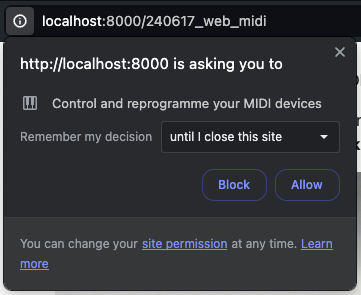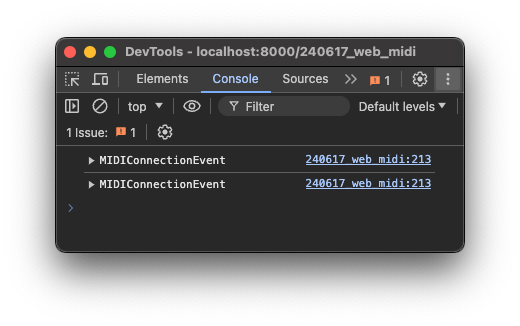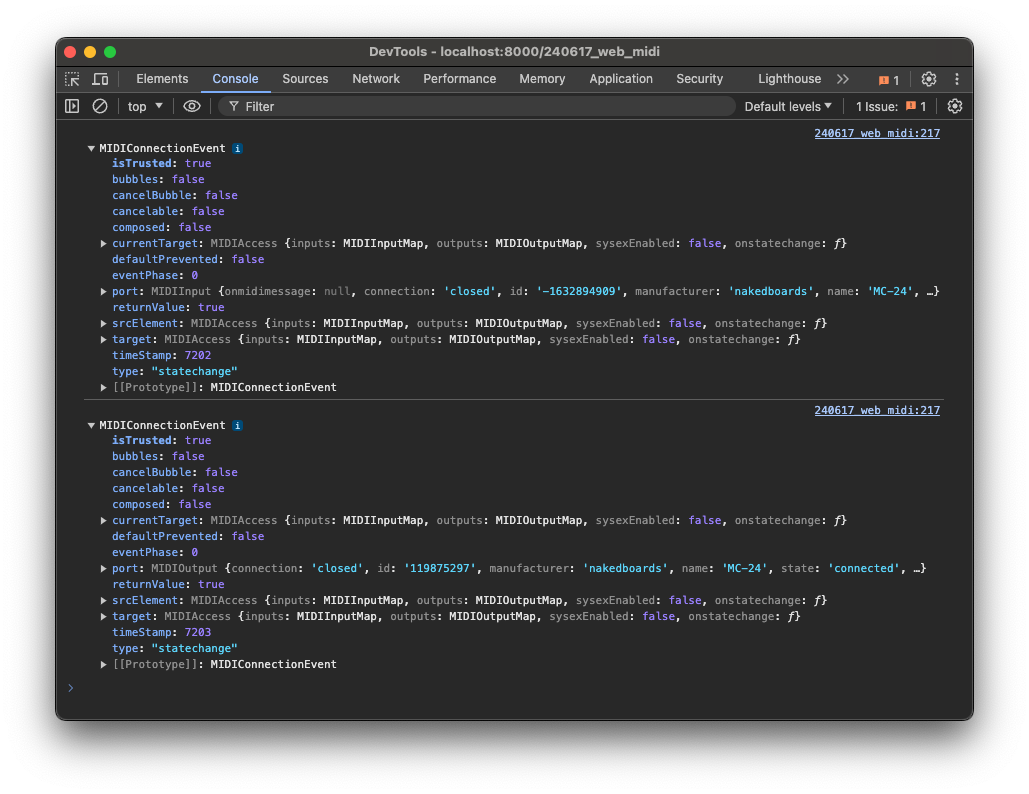Web MIDI API
← Back to homeThis post will detail how to implement MIDI control in the browser via Web MIDI API.
CAUTION: The API we will be using is not universally implementated, and already I have had trouble making this work in Firefox. Check browser compatibility → here
For the purposes of this blog post, I am using:
- Brave, running in macOS Sonoma 14.5
- nakedboards MC-24 (pictured above)
Theoretically, any USB MIDI device supported by your operating system should work.
The Navigator Object
The navigator object represents an interface with which javascript can access various information and behaviours provided by the web browser. It is through this object that we can use javascript to ask the browser for access to various aspects of the device's hardware, such as USB MIDI devices that might be connected, for example.
Technically, navigator is a property of the window object (so, window.navigator) but we can also just access it via the variable name navigator, which we get for free when our javascript is run in a browser.
MIDI Permissions
We can use:
navigator.permissions.query ({
name: `midi`,
sysex: true
})... to check whether your browser has permission to access connected USB MIDI devices.
<div id="midi_query">click to query MIDI permissions</div>
<script type="module">
const div = document.getElementById ('midi_query')
div.width = div.parentNode.scrollWidth
const height = `${ div.width * 9 / 32 }px`
Object.assign (div.style, {
height, lineHeight: height, backgroundColor: `darkmagenta`,
fontWeight: `bold`, fontStyle: `italic`, textAlign: `center`,
fontSize: `36px`, color: `white`
})
div.onpointerdown = async e => {
const response = await navigator.permissions.query ({
name: `midi`,
sysex: true
})
const handler = {
prompt: () => div.style.backgroundColor = `sienna`,
granted: () => div.style.backgroundColor = `darkolivegreen`,
denied: () => div.style.backgroundColor = `crimson`
}
handler[response.state] ()
div.innerText = response.state
}
</script>While permission state of "prompt" means that if a MIDI Access Request is made in your javascript, a prompt to appear for users to confirm the Web MIDI API's permission status:

... a permission status of "granted" will allow connected USB MIDI devices to appear on the MIDIAccess object returned by the access request, and a permission status of "denied" will not allow your javascript to communicate with connected USB MIDI devices.
Requesting MIDI Access
We can request access to the Web MIDI API with:
navigator.requestMIDIAccess ()... which will return a MIDIAccess object, which has .inputs, .outputs, and sysexEnabled properties.
As we want to use a MIDI controller (as opposed to a MIDI instrument), we will be focussing on the MIDIInputMap object accessible via the .input property.
Consider the following code (comments are provided inline):
<div id="midi_request">click to request MIDI access</div>
<script type="module">
const div = document.getElementById (`midi_request`)
div.width = div.parentNode.scrollWidth
const height = `${ div.width * 9 / 32 }px`
Object.assign (div.style, {
height, lineHeight: height, backgroundColor: `darkmagenta`,
fontWeight: `bold`, fontStyle: `italic`, textAlign: `center`,
fontSize: `36px`, color: `white`
})
div.onpointerdown = async () => {
// request MIDI access &
// assign MIDIAcess object to 'midi'
const midi = await navigator.requestMIDIAccess ()
// initialise empty string
let str = ``
// iterate over the MIDIInputMap object to
// go through the list of input devices
midi.inputs.forEach (device => {
// add each device's
// manufacture and name
// to the string
str += `${ device.manufacturer } ${ device.name }\n`
})
// if the string is still empty
// give it 'no inputs detected' message
str = str == `` ? `no inputs detected` : str
// print the string into the div
div.innerText = str
}
</script>It is worth noting that the elements being passed to the device parameter, in the code above, are instances of MIDIInput.
Plugging In, and Unplugging, MIDI Devices
It is also worth noting that we can handle changes on the hardware side of Web MIDI API by assigning a handler function to the .onstatechange property of the MIDIAccess object returned by .requestMIDIAccess (). For example:
const midi = await navigator.requestMIDIAccess ()
midi.onstatechange = e => console.dir (e)... will print a MIDIConnectionEvent to the console any time a USB MIDI device is plugged in, or unplugged.
Plugging in the MC-24 prints two such event objects to the console:

If we inspect the .port attribute of each object, we can see that the two objects are in fact not identical: one represents an input device, the other, an output device:

With this knowledge, we can handle plugging in and unplugging behaviour explicitly.
For example, try connecting (or disconnecting), a USB MIDI device:
<div id="plug_midi"></div>
<script type="module">
const div = document.getElementById (`plug_midi`)
div.width = div.parentNode.scrollWidth
const height = `${ div.width * 9 / 16 }px`
Object.assign (div.style, {
height, backgroundColor: `darkmagenta`,
fontWeight: `bold`, fontStyle: `italic`,
fontSize: `24px`, color: `white`
})
const midi = await navigator.requestMIDIAccess ()
midi.onstatechange = e => {
if (e.port instanceof MIDIInput) {
div.innerText += `${ e.port.name } was ${ e.port.state }\n`
}
}
</script>Receiving MIDI Messages
<div id="midi_messages">send a MIDI control message</div>
<script type="module">
const div = document.getElementById (`midi_messages`)
div.width = div.parentNode.scrollWidth
const height = `${ div.width * 9 / 32 }px`
Object.assign (div.style, {
height, lineHeight: height, backgroundColor: `darkmagenta`,
fontFamily:`monospace`, textAlign: `center`,
fontSize: `36px`, color: `white`
})
// function for making strings the same number of characters
const rectify = (s, w, c) => {
if (s.length >= w) return s
else return (Array (w).join (c) + s).slice (-w)
}
// define a handler for midi messages
const midi_handler = e => {
const control = rectify (e.data[1], 2, `0`)
const value = rectify (e.data[2], 3, `0`)
div.innerText = `${ e.target.name }: control ${ control }, value ${ value }`
}
// assign the handler to already connected devices
const midi = await navigator.requestMIDIAccess ()
midi.inputs.forEach (device => {
device.onmidimessage = midi_handler
})
// if a new device connects, assign the handler to it as well
midi.onstatechange = e => {
if (e.port instanceof MIDIInput && e.port.state === `connected`) {
e.port.onmidimessage = midi_handler
}
}
</script>It is worth noting that the midimessage event passed into midi_handler contains an array of length three on its .data property, the first of which representing "status", which in the case of MIDI control messages, will always be 176.
As the status information is not super important in this use case, we can ignore it, and instead use the second and third elements of the .data array, which represent "controller" and "value", respectively.
Control Knob
<canvas id="knob"></canvas>
<script type="module">
const cnv = document.getElementById (`knob`)
const w = cnv.parentNode.scrollWidth
cnv.width = w
cnv.height = w
const ctx = cnv.getContext (`2d`)
const tau = Math.PI * 2
// function takes a control number
// and a value between 0-127
// and draws a knob to the canvas
const midi_knob = (c, v) => {
const r = tau * 0.75 * v / 127
const k = tau * -0.125
const p1 = {
x: (w * 0.5) + (w * 0.4 * Math.sin (k - r)),
y: (w * 0.5) + (w * 0.4 * Math.cos (k - r))
}
const p2 = {
x: (w * 0.5) + (w * 0.2 * Math.sin (k - r)),
y: (w * 0.5) + (w * 0.2 * Math.cos (k - r))
}
ctx.fillStyle = `darkmagenta`
ctx.fillRect (0, 0, w, w)
ctx.strokeStyle = `white`
ctx.lineWidth = w * 0.1
ctx.beginPath ()
ctx.arc (w * 0.5, w * 0.5, w * 0.3, r, tau * 0.75 + r, false)
ctx.moveTo (p1.x, p1.y)
ctx.lineTo (p2.x, p2.y)
ctx.stroke ()
ctx.fillStyle = `white`
ctx.font = `bold ${ w * 0.2 }px sans-serif`
ctx.textAlign = `center`
ctx.fillText (v, w * 0.5, w * 0.57)
ctx.font = `bold ${ w * 0.15 }px sans-serif`
ctx.textAlign = `left`
ctx.fillText (c, w * 0.03, w * 0.15)
}
// define a handler for midi messages
const midi_handler = e => midi_knob (e.data[1], e.data[2])
// assign the handler to already connected devices
const midi = await navigator.requestMIDIAccess ()
midi.inputs.forEach (device => {
device.onmidimessage = midi_handler
})
// if a new device connects, assign the handler to it as well
midi.onstatechange = e => {
if (e.port instanceof MIDIInput && e.port.state === `connected`) {
e.port.onmidimessage = midi_handler
}
}
midi_knob (0, 0)
</script>